- Home
- Daisy Painting
You Can Confidently Do This Easy Daisy Painting!
Today we will be doing an easy daisy painting with oil paints.
Learn professional painting tips and speed up your art journey. Oil paints were the favorite medium of the Old Masters. Oils produced an undeniable richness to their classic paintings.
Daisies come in a variety of bright cheerful colors. We will be painting five white daisies.
Odd numbers make the viewers feel more comfortable. Any number like 3, 5 or 7 is fine for your painting.
You may want to add a butterfly or a bee to give your painting added interest.
 Let's Paint Daisies
Let's Paint Daisies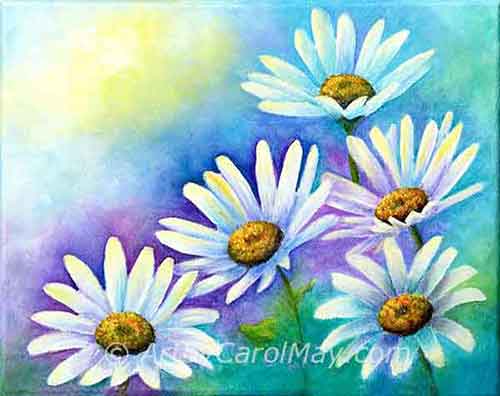 Let's Paint Daisies
Let's Paint DaisiesWhat Do You Need for Your Daisy Painting?
Get your supplies together for your painting.
All You Need Is 5 Colors
Modern oil paints are easy to use. Unlike the Old Masters we
don't have to make them. We just head out to the paint store
for these classic paints.
- Winsor Yellow
- Burnt Sienna
- Permanent Rose or Alizarin Crimson
- Thalo Blue or Ultramarine Blue
- Viridian or Sap Green
Naturally you will need white for the white daisies. Titanium white is the best.
This painting is done with Griffin alkyd paints made by Winsor & Newton.
Alkyds are the modern 'oil paints'. They handle and look just like the classic oil paints, except they dry overnight.
What Do You Paint On?
A gallery-wrap canvas is great because you may continue the painting around the sides of the canvas. Then the finished painting may be displayed without a frame. How awesome is that!
This painting is on a 11x14 gallery-wrapped canvas.
How to Paint a Daisy
Sketch the daisies on the canvas with an ordinary graphite pencil or thinned yellow paint.
Paint the Background
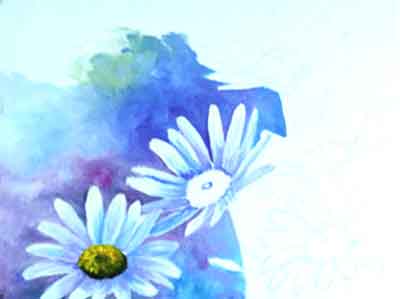 Start painting the background
Start painting the backgroundStart painting the dark background colors around the white flowers.
A variation of colors in the background gives added interest to your daisy painting.
Use your blue, plus blue mixed with Permanent Rose to create a purple.
There will be warm yellow in the flower petals. So purple (the compliment of yellow) will make the white flowers stand out and come forward from the background.
Paint the Petals
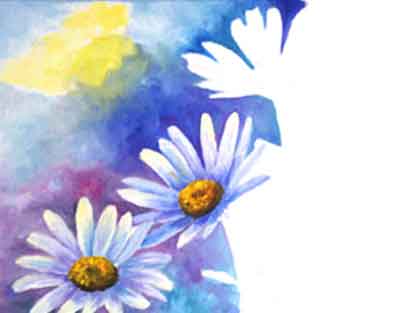 Paint the base of the petals
Paint the base of the petals- Use the background color (either blue or purple) at the base of each petal where it attaches to the center of the flower.
- Mix some white with the background color and paint the middle section of each petal.
- Mix white with a bit of yellow. Paint it on the ends of the petals and pull it back into the middle section color.
Softly blend the yellow-tinted paint into the middle color, so there is no definite line from one color to the next color.
Indicate the Light Source
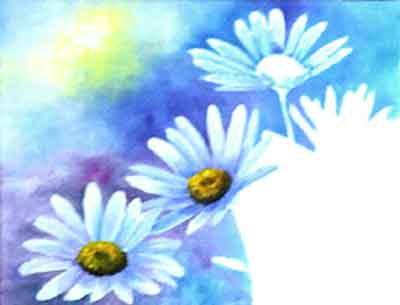 Continue painting the background
Continue painting the backgroundAdd some yellow into the top left background to indicate the light source.
Paint the background on the top right side somewhat lighter.
Make the background darker around the center daisy.
The high contrast around the center daisy will draw the eye into the painting.
What are more ways to create a focal point?
Softly blend the background colors.
Paint the Daisy Buttons
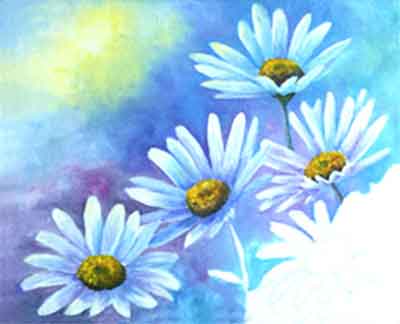 Paint the daisy buttons
Paint the daisy buttons- Put the dark color on the bottom edge of each center button.
Mix the dark with Thalo Blue, Permanent Rose and Burnt Sienna. The dark color on the bottom of the buttons indicates shadow and gives them contour and form. - Paint burnt sienna on the center of the buttons.
- Paint yellow on the top of the buttons facing the light source.
When you do a daisy painting, there is generally a dark indentation in the center of each button.
Paint Dark to Light
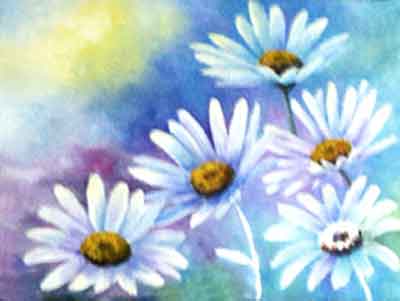 Work dark to light
Work dark to lightOil painting is done from dark to light, the reverse of watercolor.
Continue painting each daisy and its background.
It works best to do the background first. Then paint the white petals out over the background.
If the flowers are painted before the background, you are taking a chance of pulling the white off of the petals into the dark background.
Notice the bottom left flower overlaps the center flower to set it farther back into the painting. The petals on the left flower are a warm white. The flower behind has cooler, greyer petals to set it behind.
Stems and Leaves
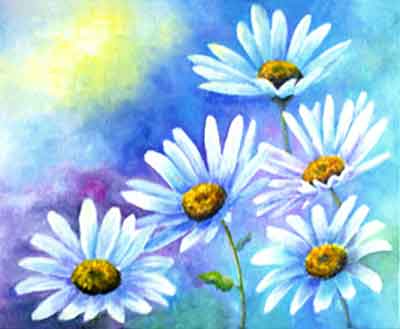 Suggest some stems and leaves
Suggest some stems and leavesContinue with each daisy, painting the background around it before you paint the daisy.
Use the corresponding background color at the base of each petal.
Paint
the button after the petals. Add a shadow on the
underside and highlights on the top of the button.
Suggest some stems and leaves with your green.
Notice the side of the stems and tops of the leaves are lighter toward the sunlight.
It's your choice, how many leaves and stems are in your daisy painting.
Get a Fresh Look at Your Painting
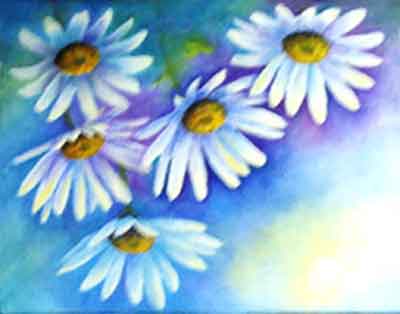 Look at your painting upside-down
Look at your painting upside-downLooking at your painting upside down will give you a fresh look at the composition, values and color movement.
Make any adjustments that catch your eye.
I decided to make the lower right corner and the center bottom darker to help ground the painting and keep it from floating.
I also lighted the purple and blue background above the two left flowers to soften the painting a bit.
What a Delightful Daisy Painting!
 You Can Do It!
You Can Do It!5 Easy Steps for Painting Daisies
1. Assemble your materials and sketch the daisies on the canvas.
2. Paint the dark background before the white flowers.
3. Paint the petals with the background colors in the shadowed areas and highlight the sun-kissed areas with a warm white.
4. Paint the center buttons from dark to light to show their contour.
5. Paint the leaves and stems as you desire.














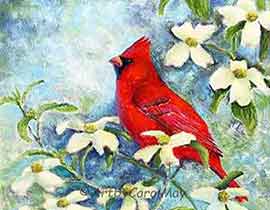 How do we create a focal point in art? Where do we put the focal point? How do we find the focus of an artwork? Should all paintings have a center of interest or can they have more than one? Learn fro…
How do we create a focal point in art? Where do we put the focal point? How do we find the focus of an artwork? Should all paintings have a center of interest or can they have more than one? Learn fro…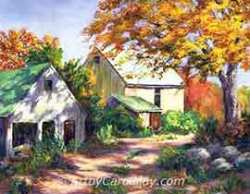 Art elements and principles appear over and over in good paintings. The elements and principles work together for us to create successful artwork. Art principles are the rules that govern how an artis…
Art elements and principles appear over and over in good paintings. The elements and principles work together for us to create successful artwork. Art principles are the rules that govern how an artis…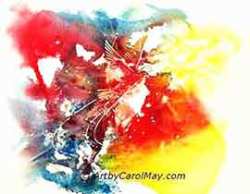 Artists often use the meaning of color to convey emotions, sentiments, and symbolism. Are you intrigued by the idea that colors can enhance or suppress different aspects of your paintings? Let's look…
Artists often use the meaning of color to convey emotions, sentiments, and symbolism. Are you intrigued by the idea that colors can enhance or suppress different aspects of your paintings? Let's look…